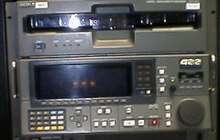D-1 (Sony)
 Sony DVR-2000 D1 VCR | |
| Media type | Magnetic Tape |
|---|---|
| Encoding | NTSC, PAL |
| Read mechanism | Helical scan |
| Write mechanism | Helical scan |
| Standard | Interlaced video |
| Developed by | Sony |
| Usage | Video production |

D-1 is an SMPTE digital recording video standard, introduced in 1986 through efforts by SMPTE engineering committees. It started as a Sony and Bosch - BTS product and was the first major professional digital video format. SMPTE standardized the format within ITU-R 601, also known as Rec. 601, which was derived from SMPTE 125M and EBU 3246-E standards.
Format
D-1 stores uncompressed digitized component video, encoded at Y'CbCr 4:2:2 using the CCIR 601 raster format with 8 bits, along with PCM audio tracks as well as timecode on a 3/4 inch (19 mm) Videocassette tape. Uncompressed component video used enormous bandwidth, 173 Mbit/sec (bit rate), for its time. The maximum record time on a D-1 tape is 94 minutes. The D-2 system soon followed, using composite video in order to lower the bandwidth needed.
D-1 resolution is 720 × 486 for NTSC systems and 720 × 576 for PAL systems; these resolutions come from Rec. 601 and are also used in DVD-Video and Standard-definition television. The D1 units are switchable between NTSC and PAL. Luma is sampled at 13.5 MHz and Chroma at 6.75 MHz with an overall data rate of 27 MHz. Sample at 13.5 MHz was used as it is a common multiple of NTSC/PAL line rate (6x 2.5 MHz). The first input\output interface was a 25 pin parallel cable (SMPTE 125M) and later updated to serial digital interface on coaxial cable (SDI, SMPTE 259M, 75Ω coax, 270 MHz). Ancillary data can be put in H/V blanking intervals. Color space for Y’ B’-Y’ R’-Y’ is also defined in ITU Rec. 601 or Rec. 709 color space.
Panasonic's D-5 format has similar specifications, but was introduced much later.
Use
D-1 was notoriously expensive and the equipment required very large infrastructure changes in facilities which upgraded to this digital recording format. Early D-1 operations were plagued with difficulties, though the format quickly stabilized and is still renowned for its superb standard definition image quality (Larcher, D. (2011). Digital Video Tape Recorder. Objects of Knowledge, of Art and of Friendship. A Small Technical Encyclopaedia. For Siegfried Zielinski. D. Lynk and N. Röller. Leipzig, Institut für Buchkunst: 30-31.)
Models
Sony
- DVR-1000
- DVR-2000
- DVR-2100
BTS
- DCR-100
- DCR-300
- DCR-500
External links
- Grotticelli, Michael, ed. (2001). American Cinematographer Video Manual. The ASC Press, Hollywood, CA. ISBN 0-935578-14-5
- Sony.com DVR-1000 page
- Sony History: The Beginning of the Digital Age
- lurkertech.com digital standard
- nfsa.gov.au The National Film and Sound Archive of Australia, TV
- smpte.org, The User Requirements for the 4:2:2 Component Digital VTR, by William C. Nicholls
- ovguide.com D1
- teranex.com D1
- BTS DCR-100 specs
- fernsehmuseum.info BTS DCR-100 German
- fernsehmuseum.info BTS DCR-500 German
- vidiot.com Michael Hurst Interview, Part 2, Amazon High & Production Techniques
- Multidimensional signal, image, and video processing and coding, page 381, By John William Wood
- moviola.com on D1
- The filmmaker's handbook: a comprehensive guide for the digital age, By Steven Ascher, Edward Pincus
- rohde-schwarz.com SMPTE TU-R 601 standard
- tech.ebu.ch Rec 601 the origins of the 4:2:2 DTV standard
- TI CLC021 SMPTE 259M Digital Video Serializer with EDH Generation and Insertion
- afterdawn.com itu r bt 601
- [http://www.intersil.com/data/an/an9728.pdf intersil.com BT.656�Video�Interface�for�ICs]
- lipas.uwasa.fi A Quick Guide to Digital Video Resolution and Aspect Ratio Conversions
